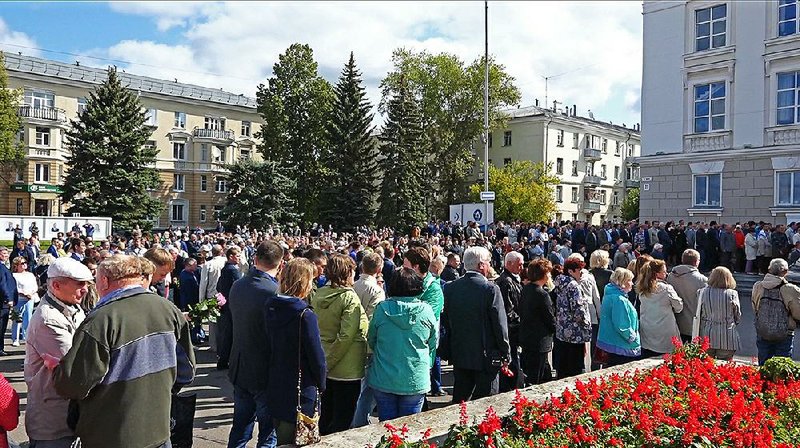MOSCOW -- Thousands of Russians attended the funerals Monday of five Russian nuclear engineers killed by an explosion as they tested a new rocket engine, a disaster that fueled radiation fears and raised new questions about a secretive weapons program.
The engineers, who died Thursday, were laid to rest Monday in Sarov, which hosts Russia's main nuclear weapons research center, where they worked. Flags flew at half-staff in the city, 230 miles east of Moscow, which has served as a base for Russia's nuclear weapons program since the late 1940s. The coffins were displayed at Sarov's main square before being driven to a cemetery.
The Defense Ministry initially reported that the explosion at the navy's testing range near the village of Nyonoksa in the northwestern Arkhangelsk region killed two people and injured six others. The state-controlled Rosatom nuclear corporation then said over the weekend that the blast also killed five of its workers and injured three others. It's not clear what the final toll is.
The company said the victims were on a sea platform testing a rocket engine and were thrown into the sea by explosion.
Rosatom Director Alexei Likhachev praised the victims as "true heroes" and "pride of our country."
Rosatom said the explosion occurred while the engineers were testing a "nuclear isotope power source" for a rocket engine. Local authorities in nearby Severodvinsk, a city of 183,000, reported a brief spike in radiation levels after the explosion but said it didn't pose any health hazards.
Still, the statement from Severodvinsk's administration came just as the Defense Ministry insisted that no radiation had been released, a claim that drew comparisons to Soviet-era attempts to cover up catastrophes. Spooked residents rushed to buy iodide, which can help limit the damage from exposure to radiation.
After the explosion, Russian authorities also closed part of Dvina Bay on the White Sea to shipping for a month, in what could be an attempt to prevent outsiders from seeing an operation to recover the missile debris.
The Severodvinsk city administration said the radiation level rose to 2 microsieverts per hour for about 30 minutes on Thursday before returning to the area's natural level of 0.1 microsieverts per hour. Emergency officials issued a warning to all workers to stay indoors and close the windows.
The radiation level of 2 microsieverts per hour is only slightly higher than the natural background radiation, which could vary between 0.1 and 0.4 microsieverts per hour. It's lower than the cosmic radiation that plane passengers are exposed to on longer haul flights.
Regional authorities haven't reported any radiation increases after Thursday's spike.
Neither the Defense Ministry nor Rosatom mentioned the type of rocket that exploded during the test, saying only that it had liquid propellant.
But Rosatom's mention of a "nuclear isotope power source" led some Russian media to conclude it was the Burevestnik, or Petrel, a nuclear-powered cruise missile first revealed by Russian President Vladimir Putin in March 2018 during his state-of-the nation address along with other doomsday weapons.
While presenting the new missile, Putin claimed it will have an unlimited range, allowing it to circle the globe unnoticed, bypassing enemy missile defense assets to strike undetected. The president claimed the missile had successfully undergone the first tests, but observers were skeptical, arguing that such a weapon could be very difficult to handle and harmful to the environment.
Some reports suggested that previous tests of the Burevestnik missile had been conducted on the barren Arctic archipelago of Novaya Zemlya and the Kapustin Yar testing range in southern Russia before they were moved to Nyonoksa. Moving the tests from unpopulated areas to a range close to a big city may be a reflection of the military's increased confidence in the new weapon.
A Section on 08/13/2019
